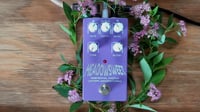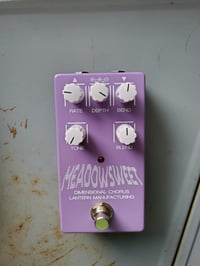Meadowsweet
This is the Meadowsweet from Lantern Manufacturing.
The Meadowsweet is a “dimensional” chorus based on a quad pt2399 design - a chipset that was intended for echo and delay applications, but never chorus. You can use it for such of course, but you have to treat it just right. Since the Meadowsweet uses four pt2399s, that means it has four distinct voices, each with their own individual chorus/delay times (two shorter, two longer). This effectively
makes the Meadowsweet a chorus ensemble - and a lush one at that.
The Meadowsweet also employs a standard and inverted LFO signal, with one of each set of pt2399s receiving a standard and inverted LFO signal, giving the modulation a sense of motionlessness. This is where we get the term "dimensional chorus".
The Meadowsweet achieves all of this using conventionally and readily available
components, not BBDs or DSP (there's nothing wrong with either of those, I'm just not smart enough to figure them out). There are a wonderful number of pedals that can do what the Meadowsweet can do (and more!), but none that I know of that do it quite like it does. Simply put: it's not what the Meadowsweet does, but how it does it.
This pedal uses a standard 9VDC center negative power supply (no batteries), drawing roughly 137mA during operation (powering up may take more current). The controls are as follows:
Rate: controls the speed of an LFO and its inverted signal. Turn the knob to the right or left to increase or decrease the speed accordingly.
Depth: controls the depth of the chorus effect. Turning the knob to the right or left increases or decreases the strength of the chorus effect. A more subtle effect can be achieved by keeping the Depth knob below noon, and a lush soundscape opens up beyond this.
Bend: controls the delay time of the two PT2399 chipsets with longer delay times (one signal inverted from the other). Turning the knob to the right or left will increase or decrease the overall delay time. From fully counterclockwise up until around noon enriches the chorus effect, while past noon adds proportional reverb and delay to the signal just beyond the range of ‘slap back” echo. This control is called “Bend” because of its ability to create a tape-like “wow” effect when the Depth and Bend knobs are both set past noon clockwise. Essentially, the “wow” effect is dependent on the interplay between the Bend and Depth knobs - more Depth equals more “wow”, and vice versa. Adjust to taste.
Tone: controls a low pass filter that will cut out high frequency content as you turn it clockwise, darkening the tone of the delay lines (but not the dry signal).
Blend: controls the dry/wet balance of the effect. Dry signal is fully counterclockwise, chorus is at noon, and vibrato is fully clockwise.
Enjoy!


